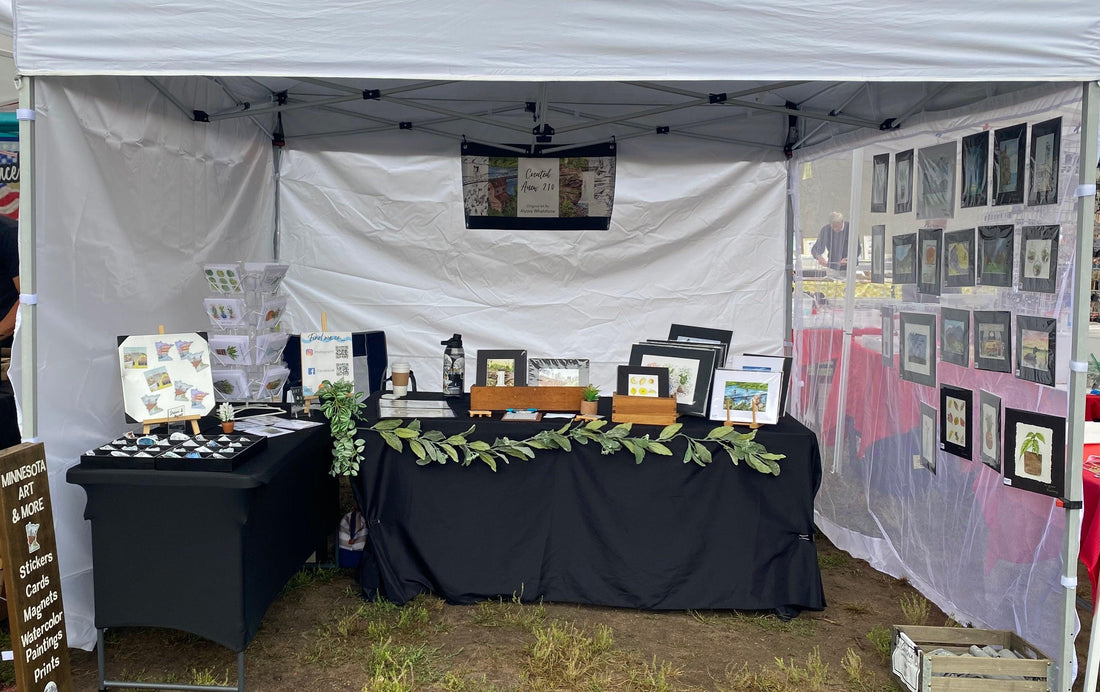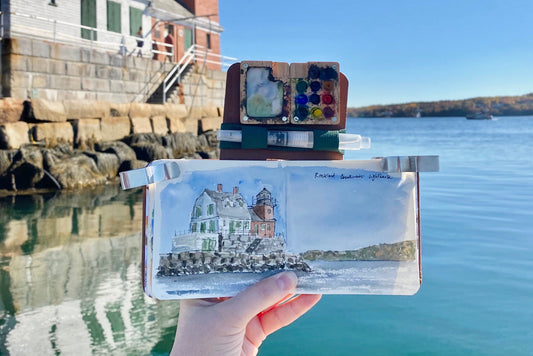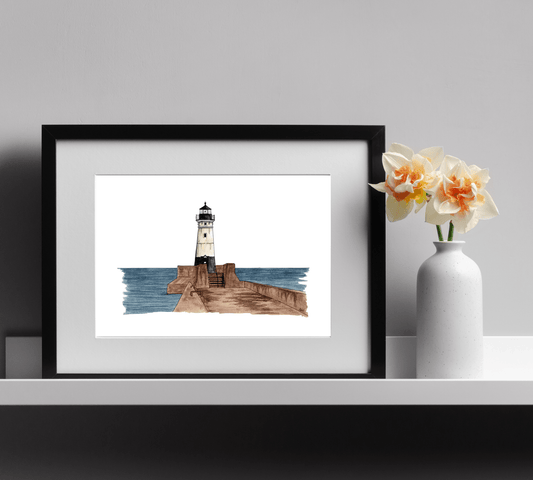
All My Art Print Secrets: From Making to Selling
Share
So you paint. You can sell originals, but you've only got one of those, so it's best if you can sell prints too. I am going to walk through each part of how I prepare and sell prints of my watercolor paintings from the paper to the packaging. I'll include links to what I use and who I buy from. Some may be affiliate links where I earn a small percentage in return for recommending it. Everything I share with you, I use and trust.
First, what is a print?
A print is a copy of your art. Prints can be the same size as your original, smaller, or larger depending on the quality of your scan. Prints should be printed on archival-quality paper. You might hear the term Giclee thrown around (pronounced zhee·klay) which can be used for a wide variety of papers. The main thing to confirm is that it is archival and acid-free.
Here are two main online printing companies I have used and recommended.
They are a family-owned and operated business out of Buffalo, New York. They have wonderful customer service and very high-quality prints. Their prices are higher than others, but that's for a good reason. I used them exclusively for a while, but have decided to save their quality for special editions or limited series (more on that later).
They ship fast and offer free shipping with a minimum order.
When you register your account, type in "TWEET-Alyssa Whetstone" to get $10 toward your purchase!
Gicleetoday.com offers quality prints at a lower price. While I still prefer iprintfromhome.com's quality, I use gicleetoday for my open-edition prints and on-demand printing when customers order online. They do not have any free shipping threshold so it pays to order in bulk since you'll have to pay for shipping each time you order.
Both iprintfromhome.com and gicleetoday.com are great options for ordering prints online and they have a variety of paper types. Both also have the option of ordering paper samples so you can see which is best for you. I prefer the Somerset Velvet Giclee paper.
Printing your own Prints
I have recently started printing my own prints. I use Canon Pixma iX6820 which is a photo-specific printer. The big thing I needed to print my own prints was edge-to-edge printing. If you are an artist who wants a buffer or border around your art then that might not be important. Along with the edge-to-edge printing capabilities, it has great photo-specific colored ink.
Once you've got a printer, then you need paper. I found Red River Paper recommended by other artists who print their own and I currently use their linen paper so it has a bit of texture to it. I'll probably do some more testing of their other paper so I'll update this as I do. The paper takes the photo ink very well, it also feels and looks high quality.
How to turn your original into a print
There are two main ways to turn your original into a print, scan or photograph. I recommend scanning because there is less editing you have to do afterward. However, if your artwork is too large for your printer's scanner, you may need to go to a professional printing company that has a large scanner, or else you'll need to use a camera.
Once you scan your painting the most important thing to check (and possibly edit) is the color. It should be in focus and you can't usually change the quality of the scan, but you want the color to match your original. Often times your image might be cooler or warmer than the original so adjusting the color temperature is a good place to start.
If you're working with small-size files and small prints (8x10 in or smaller) you can probably edit the image right in your computer's photo editing software that pops up when you open the image. If your image is larger or you have and understand Photoshop, then that's a great place to make your changes too.
When editing your scanned or photographed files, I recommend saving separate files for each major edit you make. I'm guessing you'll eventually want to sell the original so you won't be able to re-scan it if you need to change something. Get organized with your files and keep both the raw and edited versions of your art.
Packaging a print to sell
You've scanned, edited, and printed your prints. Now it's time to sell. I suggest packaging each print in a plastic sleeve with a backing board. If you sell small prints you could also matte them to make them feel larger. I offer my 5x7 and 8x10 prints both matted and without a matte and price them differently.
You can find all you'll need for that here at clearbags.com. I have used their backing and plastic sleeves for my own prints.
When it comes to backing board, first I tried using their Bainbridge® Alphamount ArtCare White Backing but found it a bit thin so I now use their Double-thick Bainbridge® Utility Backing Board which stays very stiff and is easy for a customer to flip through when looking at prints in a basket at my table.
I also order my plastic sleeves through them because they carry eco-friendly plastic bags, the Premium Eco Clear Bags.
Clear Bags also has shopping bags so I order those through them too. While they do have an eco-friendly handled bag, it dissolves in water and I don't want to risk damage to my product if it's raining at an event, So I order these Clear Handle Bags instead. I used to use paper bags, but then I heard this pro tip: by giving your customers a clear bag to carry your art around it, you get free advertising. Others can see that art and wonder and maybe even ask where it came from. While you can put your branding on a paper bag, no one will see what you sell. Just a thought 😉
If you're looking for an all-in-one kit then I recommend this set of backing, mattes, and plastic sleeves from amazon. I've used these for years and they're a great price. I prefer black mattes for my art but of course, you pick what works for yours. This same brand also has white.
Displaying your sale-ready prints
Now that you've done all the behind-the-scenes work, how do you actually show off these prints?
I do a mixture of hanging and tabletop baskets.
When hanging your prints, you will want a tab like these to attach to the plastic sheet so you can actually hang it up. If I have an indoor event I use these grid walls with these hooks to display hanging art.
If you're at an outdoor event and have a tent set up, then using mesh walls like these can be a great alternative so you don't have to pack both metal grids and a tent into your car. If you hang art on the mesh wall you can just use half-unfolded paper clips to do the job like I do 😂 art business isn't always so fancy.
If you're using a tabletop display, you'll want baskets, boxes, or bins, that are shallow enough not to cover up your prints, and narrow enough to keep them standing, but wide enough that the prints fit inside. Basically, I recommend bringing a packaged print with you to a hobby store or home decor store and setting it in different containers to see what works best and fits your art's vibe.
Remember to always check out your own home first; you might be surprised to find you already have some useful items there.
Actually selling your prints
Finally, you're ready to make some money off of these copies. If you're selling them in person, I recommend making a list of sizes and prices. Most often prints are priced based on size, not subject, since they all cost the same to make.
The exception to this is limited edition or print series. If you have a limited number of prints, or if they are signed prints, then they can cost more than their same-sized neighbors. Make sure to mark accordingly if you have both for sale.
It helps to post this list of sizes and prices in multiple places, wherever prints are displayed. Many customers may still turn over the print and look for the price on the back, so if you want you can label them individually even if the prices are all the same.
If you are selling your prints online, you may be able to skip a lot of the packaging and display. If you choose to drop ship your prints, then the company printing them will package them for you and you never even see the print. This is great so you don't have to keep a large stock on hand and pay for shipping twice. I always recommend seeing some prints in person before trusting a company to deliver your print-on-demand orders to your customer.
So there you have it.
These are all my secrets for preparing and selling your fine art prints. Let me know if you have any other questions through the comments below or by sending me an email!
Stay creative!
-Alyssa



